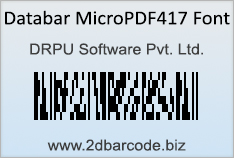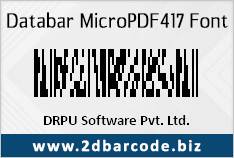

DataBar MicroPDF417 is 2D bar code used to encode data in a two-dimensional (2D) symbol (up to 150 bytes, 250 alphanumeric characters, or 366 numeric digits). Databar MicroPDF417 is based on PDF417 standard. MicroPDF417, unlike PDF417, may only be printed in certain defined combinations of rows, columns, and error correction codewords, up to a maximum of four data columns by 44 rows.
Each Micro PDF417 symbol consists of a stack of vertically aligned rows supporting one, two, three or four columns. A minimum of 4 rows and a maximum of 44 rows are supported. Unlike PDF417 which uses Start and Stop patterns, Micro PDF417 uses patterns call Row Address Patterns. These patterns are placed at the left and right of each row.
DataBar Micro PDF417 barcode is very similar to PDF417 except that it provides a limited set of symbol sizes. For each symbol size, a fixed level of error correction is supported. All the specified symbols support at least 28% of error correction codewords.
The data is encoded using one of three modes: Text compaction mode, Binary compaction mode, and Numeric compaction mode.
2D Barcode Fonts
